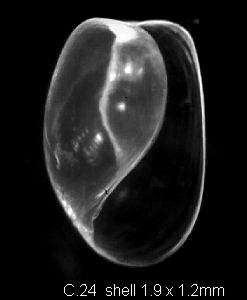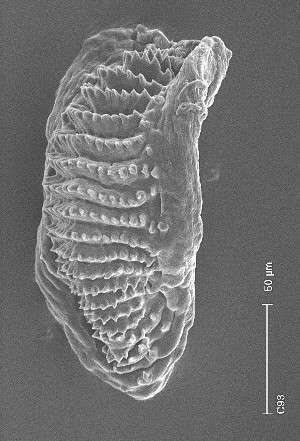Re: is this an opisthobranch?
August 11, 1999
From: C. Carlson & P.J.Hoff


Bill,
Atsushi Ono's animal is actually a haminoeid form.
We have 7 species from Guam that appear to represent a new genus. The shell is very thin and transparent with little or no fold of the columella. It is delicate enough that it can be broken with a light jet of water. The gizzard plates are lightly chitinized with ridges made up of single rows of rods. The radulae that we have looked at have a
formula of 2.1.2. Some of these have been asymmetric; the outer edge of the first left lateral being denticulate and the corresponding right lateral, smooth. Externally the group is marked by a modified head shield, very thin parapodia and an extended tail. In at least two species there is an adhesive area at the end of the tail. When threatened, the animal jerks back to its point of attachment. We have one of the least modified forms on Mike Miller's web site as Branch of the Week #109.
UPPER PHOTO (C.24) Shell, 1.9 x 1.2; 2.7mm live (w/o tail); Guam, Bile Bay, 4m; 19 April 1988
LOWER PHOTO: (C.93) Gizzard plate; animal w/2.1 x 1.25mm shell; Guam, Bile Bay, 12m; 3 July 1998
Unless we have a good view of the head shield, we cannot tell if Mr Ono's specimen is the same as any of the Guam specimens.
(The C.24, C.93 are code numbers in our species list. The animal shown on Mike's site is C.94.)
Clay & Patty Jo
Merizo, Guam
clay.carlson@kuentos.guam.net
Carlson, C. & Hoff, P.J., 1999 (Aug 11) Re: is this an opisthobranch?. [Message in] Sea Slug Forum. Australian Museum, Sydney. Available from http://www.seaslugforum.net/find/1178Dear Clay & Patty Jo,
Thanks for the photos and the information.
Perhaps I saw your interesting animals on Mike's site. You instantly came to mind when I saw Atsushi's photos.
To any of you not familiar with the anatomy of haminoeids, they have a large muscular sac in the oesophagus, which is called the gizzard. It is armed with three large similarly shaped hard plates which are used to grind their plant food. The size, shape and number of the ridges on the plates is quite a useful generic character within the family.
Bill Rudman.
Related messages
-
Re: Long-tailed mini haminoeid from New South Wales
From: Clay Carlson, May 26, 2007 -
Long-tailed mini haminoeid from New South Wales
From: Nerida Wilson, May 7, 2007 -
Re: Haminoeid from Kerama Id
From: C. Carlson & P.J. Hoff, October 13, 2000 -
Diaphanid from Kerama Id is haminoeid
From: C. Carlson & P.J. Hoff, October 10, 2000 -
A diaphanid from Kerama Island?
From: Atsushi Ono , October 9, 2000 -
Is this an opisthobranch?
From: Atsushi Ono, August 11, 1999
